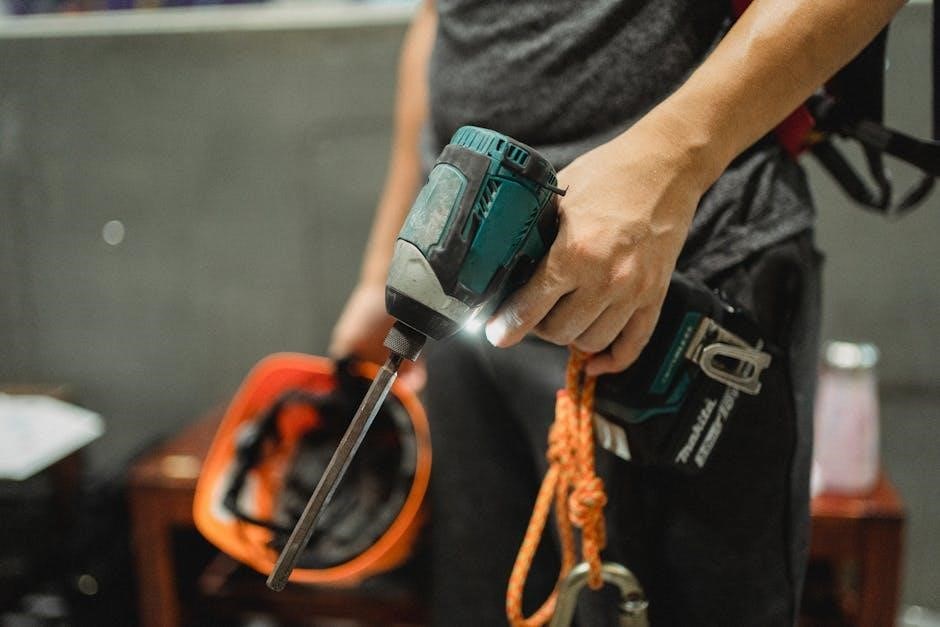Welcome to the GE Profile Double Oven Manual. This guide provides essential information for safe and efficient use of your GE Profile Double Wall Oven, model PTD7000SNSS. It covers installation, operation, and maintenance, ensuring optimal performance and longevity of your appliance. Discover features like smart connectivity and convection cooking, while adhering to safety guidelines for a seamless culinary experience.
1.1 Overview of the GE Profile Double Oven
The GE Profile Double Oven is a built-in electric wall oven designed for modern kitchens, offering advanced cooking capabilities. With features like smart connectivity and convection cooking, it provides precise temperature control and even heating. Available in models such as PTD7000SNSS, it combines sleek design with functionality, making it ideal for home cooks and professionals alike. This oven is tailored for efficient meal preparation and seamless integration into smart home systems.
1.2 Importance of Reading the Manual
Reading the GE Profile Double Oven Manual is crucial for safe and effective use. It outlines safety guidelines, such as avoiding flammable materials near the oven and preventing tip-over risks. The manual also explains how to troubleshoot issues like time-keeping problems and error codes. Understanding the installation requirements and operational features ensures optimal performance and longevity of your appliance, while preventing potential hazards.

Safety Instructions and Precautions
Always read the safety guidelines to prevent hazards. Avoid storing flammable materials near the oven and ensure stable installation to prevent tip-over risks. Follow all precautions carefully to ensure safe operation and avoid potential injuries or damage.
2.1 General Safety Guidelines
Always follow safety guidelines to ensure safe operation. Never store flammable materials near the oven or cooktop. Keep the area clear of obstructions and ensure proper ventilation. Avoid overheating cookware, as it may cause damage. Regularly inspect cords and plugs for wear. Keep children away from hot surfaces and controls. Failure to adhere to these guidelines may result in fire hazards or serious injury.
2.2 Specific Safety Precautions for Installation and Usage
Ensure the GE Profile Double Oven is installed by a qualified professional to avoid electrical or structural hazards. Never install near flammable materials or in areas prone to moisture. During usage, avoid leaving cooking unattended and keep children away from hot surfaces. Use oven mitts to handle hot cookware. Always follow the manufacturer’s guidelines for proper installation and operation to prevent accidents and ensure safe performance.

Installation Requirements and Recommendations
Proper installation of your GE Profile Double Oven is crucial. Ensure it is installed by a professional to meet safety standards. Refer to the manual for specific guidelines to ensure correct fit and function, and avoid placing flammable materials nearby.
3.1 Pre-Installation Checks
Before installing your GE Profile Double Oven, ensure the installation site meets all requirements. Check the oven dimensions to confirm proper fit and verify electrical connections. Inspect the appliance for damage and ensure venting is adequate. Review the manual for specific guidelines, and ensure a professional handles the installation to avoid safety risks and performance issues.
3.2 Installation Tips for New Construction
For new construction, ensure the installation site is properly prepared. Verify that the surrounding area is clear and level. Use the recommended installation kit to secure the oven. Ensure proper venting and electrical connections are in place. Hire a certified professional for installation to guarantee safety and optimal performance. Follow the manufacturer’s guidelines for a seamless integration into your kitchen design.
Key Features of the GE Profile Double Oven
Discover the standout features of the GE Profile Double Oven, including advanced convection technology, smart home integration, and voice command functionality for a modern cooking experience.
4.1 Cooking Modes and Capacities
The GE Profile Double Oven offers versatile cooking modes, including convection, roast, and bake, ensuring even cooking. With a spacious 7.0 cu. ft. total capacity, it accommodates large dishes. Dual ovens allow simultaneous cooking at different temperatures, while multiple racks and trays provide flexibility for various recipes, enhancing your culinary versatility and efficiency.
4.2 Smart Technology and Connectivity Features
The GE Profile Double Oven integrates seamlessly with smart home systems, offering voice control through Amazon Alexa and Google Assistant. Using the GE SmartHome app, you can monitor and control your oven remotely. Features like remote preheating and voice commands enhance convenience, ensuring a modern and connected cooking experience tailored to your lifestyle and preferences.

Operating the GE Profile Double Oven
Learn to efficiently operate your oven using the control panel and knobs. Select cooking modes, set temperatures, and utilize features like timers and preheating for precise control.
5.1 Using the Control Panel and Knobs
Operate your GE Profile Double Oven with ease using the intuitive control panel and knobs. Select cooking modes, adjust temperatures, and set timers using the smart display. The knobs allow precise control over burner sizes and oven functions. Ensure the clock is accurately set, as some users report time-resetting issues. Use the control lock to prevent accidental changes. Refer to the manual for troubleshooting error codes like E0-E9.
5.2 Understanding Cooking Modes and Settings
Explore the versatile cooking modes of your GE Profile Double Oven, including convection, bake, roast, and proof. Adjust settings like temperature and timer for precise control. The oven offers multi-rack cooking and smart algorithms for even heating. Use the delay start feature to plan meals. Ensure the clock is set correctly, as time accuracy affects cooking schedules. Refer to the manual for optimal mode selections and customization options.
Maintenance and Cleaning Tips
Regularly clean your GE Profile Double Oven to maintain performance. Wipe surfaces with a damp cloth and avoid harsh chemicals. Refer to the manual for specific cleaning guidelines.
6.1 Regular Cleaning Procedures
Regular cleaning is essential to maintain your GE Profile Double Oven’s performance. Wipe down surfaces with a damp cloth after each use to prevent food residue buildup. For tougher stains, mix baking soda and water to create a paste, apply it, and let it sit overnight before scrubbing. Avoid harsh chemicals or abrasive cleaners, as they may damage the finish. Clean racks by soaking them in warm soapy water. For glass windows, use a glass cleaner and a lint-free cloth. Regular deep cleaning, especially after heavy use, ensures optimal functionality and longevity of your oven.
6.2 Maintaining Oven Performance
To maintain your GE Profile Double Oven’s performance, ensure proper airflow by keeping vents clear. Avoid using abrasive cleaners to protect the finish. Check racks regularly and replace them if damaged. Use the self-cleaning feature as needed to handle tough residue. Always follow recommended temperature settings to prevent overheating. Regularly inspect door seals to ensure a tight closure, which helps in maintaining even heating and energy efficiency.

Troubleshooting Common Issues
Address common issues like uneven heating or connectivity problems with smart features. Check error codes for quick diagnoses and effective solutions to ensure smooth oven operation.
7.1 Resolving Time-Keeping Problems
If your GE Profile Double Oven clock keeps resetting, ensure it is properly connected to a power source and synced with your smart network. Check for firmware updates and reset the clock manually if necessary. Refer to the error codes section for additional guidance. Proper time-keeping is essential for accurate cooking timings and smart home integration functionality.
7.2 Addressing Common Error Codes
Refer to the GE Profile Double Oven Manual for a list of error codes and their meanings. Common issues include the clock resetting or oven malfunctioning. Check the display for specific codes, restart the oven, and ensure proper electrical connections. If errors persist, contact GE Appliances support for assistance. Regularly updating firmware can prevent recurring issues and ensure smooth operation. Always follow safety guidelines when troubleshooting.

Accessories and Optional Equipment
Explore recommended GE Profile Double Oven accessories, such as additional racks, drip pans, and smart home modules. These enhance functionality and maintenance, ensuring optimal performance and convenience.
8.1 Recommended Accessories for Optimal Performance
Enhance your GE Profile Double Oven experience with recommended accessories like additional oven racks, drip pans, and smart home integration modules. These items improve functionality, simplify cleaning, and ensure optimal performance. For convenience, explore compatible cookware and advanced sensors designed specifically for your oven. Visit the official GE Appliances website or authorized retailers to find these essential accessories tailored to your model.
8.2 Optional Features for Enhanced Functionality
Optional features such as advanced sensors, additional cooking modes, and smart home integration modules can enhance your GE Profile Double Oven’s functionality. These additions allow for precise temperature control and seamless integration with smart home systems, offering greater convenience and flexibility. Visit the official GE Appliances website or authorized retailers to explore these advanced options designed to elevate your cooking experience.
Energy Efficiency and Power Management
Energy efficiency is a key feature of the GE Profile Double Oven. Advanced sensors and eco-friendly settings optimize energy use, reducing consumption while maintaining performance. GE’s commitment to innovation ensures smarter, greener cooking solutions for modern kitchens.
9.1 Energy-Saving Features
The GE Profile Double Oven incorporates advanced energy-saving features like smart sensors and eco-friendly settings to minimize power consumption. These features optimize cooking efficiency while reducing energy use. The oven’s smart connectivity allows for remote monitoring and adjustments, ensuring optimal performance without unnecessary energy waste. GE’s commitment to sustainability is evident in these innovative, eco-conscious designs that benefit both users and the environment.
9.2 Tips for Reducing Energy Consumption
To minimize energy use with your GE Profile Double Oven, always use the correct pan size for the burner and avoid unnecessary preheating. Keep oven doors closed during cooking to maintain temperature, reducing the need for extra heating. Utilize the convection mode when possible, as it cooks faster and uses less energy. Additionally, consider scheduling cooking during off-peak energy hours to further reduce consumption.
Smart Home Integration and Voice Control
The GE Profile Double Oven seamlessly integrates with smart home systems, allowing voice control through platforms like Amazon Alexa. This feature enables remote monitoring and hands-free operation for enhanced convenience.
10.1 Compatibility with Smart Home Systems
The GE Profile Double Oven is designed to integrate seamlessly with popular smart home systems, including Amazon Alexa and Google Assistant. This compatibility allows users to control their oven remotely through voice commands or smartphone apps, ensuring a convenient and modern cooking experience. The oven’s smart connectivity enhances functionality, enabling features like remote preheating and monitoring of cooking progress.
By linking the oven to your smart home network, you can access advanced features like scheduling and custom recipes directly through the app. This integration ensures that your GE Profile Double Oven becomes a central part of your connected kitchen, offering unparalleled control and flexibility for home cooks and professionals alike.
10.2 Using Voice Commands for Oven Control
The GE Profile Double Oven supports voice commands through smart home systems like Amazon Alexa and Google Assistant. Users can preheat, adjust temperatures, and monitor cooking status hands-free. Simply link your oven to your smart home system and use voice commands for a seamless cooking experience.
This feature enhances convenience, allowing you to manage your oven without needing to physically interact with it, making meal preparation more efficient and enjoyable.
User Support and Resources
Register your GE Profile Double Oven online for warranty and support. Access online manuals, troubleshooting guides, and customer service contacts through the official GE Appliances website.
11.1 Registering Your Appliance
Register your GE Profile Double Oven online through the official GE Appliances website. Provide your appliance’s model number, located on the product label, and complete the registration form. This ensures warranty validation, access to exclusive updates, and personalized support. Registration helps GE provide tailored assistance and maintain accurate records for your appliance.
11.2 Accessing Online Manuals and Customer Support
Access the GE Profile Double Oven manual and customer support resources on the official GE Appliances website. Download the PDF manual for model-specific guidance, or explore the support section for troubleshooting, FAQs, and repair services. For assistance, contact GE customer support via phone or live chat, ensuring you have your appliance’s model number ready for efficient help.

Design and Space Efficiency
The GE Profile Double Oven features a sleek, compact design, perfect for modern kitchens. Its spacious interior accommodates multiple dishes, while adjustable racks and shelves optimize space efficiently.
12.1 Compact Design for Modern Kitchens
The GE Profile Double Oven is designed with a sleek, compact footprint, ideal for contemporary kitchens. Its built-in style integrates seamlessly into modern interiors, offering a professional look without compromising space. The oven’s slim profile allows for efficient use of kitchen real estate, while its stainless steel finish adds a touch of sophistication. This design ensures a perfect balance between functionality and aesthetic appeal.
12.2 Maximizing Oven Capacity in Small Spaces
The GE Profile Double Oven is engineered to deliver ample cooking capacity while fitting seamlessly into compact kitchens. Its space-saving design ensures efficient use of available space, with features like convection cooking for faster meal preparation. Adjustable racks and multiple cooking modes allow for versatile meal preparation, even in smaller kitchens, making it an ideal choice for modern, space-conscious homeowners.
13.1 Final Tips for Getting the Most Out of Your GE Profile Double Oven
To maximize your GE Profile Double Oven’s performance, leverage its smart connectivity for voice control and remote monitoring. Regularly clean the oven to maintain efficiency and prevent damage. Explore advanced cooking modes like convection for evenly cooked dishes. Refer to the manual for troubleshooting common issues and updating software. Always use genuine GE accessories for optimal results and longevity of your appliance.


















































